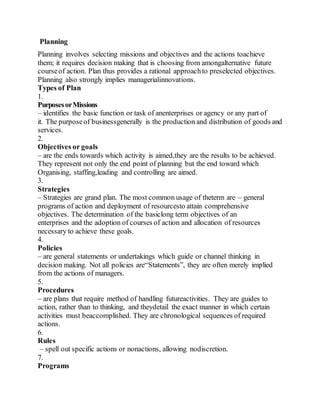
Planning
- 1. Planning Planning involves selecting missions and objectives and the actions toachieve them; it requires decision making that is choosing from amongalternative future courseof action. Plan thus provides a rational approachto preselected objectives. Planning also strongly implies managerialinnovations. Types of Plan 1. PurposesorMissions – identifies the basic function or task of anenterprises or agency or any part of it. The purposeof businessgenerally is the production and distribution of goods and services. 2. Objectives or goals – are the ends towards which activity is aimed,they are the results to be achieved. They represent not only the end point of planning but the end toward which Organising, staffing,leading and controlling are aimed. 3. Strategies – Strategies are grand plan. The most common usage of theterm are – general programs of action and deployment of resourcesto attain comprehensive objectives. The determination of the basiclong term objectives of an enterprises and the adoption of courses of action and allocation of resources necessary to achieve these goals. 4. Policies – are general statements or undertakings which guide or channel thinking in decision making. Not all policies are“Statements”, they are often merely implied from the actions of managers. 5. Procedures – are plans that require method of handling futureactivities. They are guides to action, rather than to thinking, and theydetail the exact manner in which certain activities must beaccomplished. They are chronological sequences of required actions. 6. Rules – spell out specific actions or nonactions, allowing nodiscretion. 7. Programs
- 2. – are a complex of goals, policies, procedures, rules, tasksassignments, steps to be taken, resources to be employed and other elements necessary to carry out a given courseof action; they areordinarily supported by budget 8. Budgets – is a statement of expected results expressed in numericalterms. Referred as “numberized” program. The financial operating budget is often called a “profit plan” Steps in Planning1.Being aware of Opportunity - In light of the market, competition, what customer want, our strengths and weakness 2.Setting Objectives or g oals - where we want to be and we want to accomplish and when 3.Considering Planning Premises - In what environment. Internal or External – will our plan tooperate? 4.Identifying alternatives - what are the most promising alternatives to accomplish our objectives 5.Comparing alternatives in light of goals - which alternative will give us the best chance of meeting our goals at the lowest costand highest profit 6.Choosing an alternative - Selecting the courseof action we will pursue 7.Formulating supporting plan - Such as plans to buy equipment, buy materials, hire and trainworkers. Develop a product. 8.Numberizing plans by making budgets -Developing such budgets as volume and price of sales operatingexpenses necessary for plans expenditure for capital equipment Objectives / Importance / Advantages of Planning 1.Focuses attention on objectives & results2.Reduces uncertainity and risk 3.Provides sense of direction4.Encourages innovation & creativity5. He lp s in c o o rd inatio n6.Guides decision making7.Provides a basis for decentr alization8.Provides efficiency in operation9. F ac ilitates c o ntro Features ofa goodplan 1.Based on clearly defined objectives2.Simple, easily understandable3.Flexible or adaptable to changing conditions4.must be
- 3. balanced in all respects5.must provide standards for the evaluation of performance and actions6.It should be economical7.It should be practicable8.Prepare d with the consultation of concerned persons9.Should be clear, specific and logical10.Should be capable of being controlled Types of Planning (Time limit) 1.Long term plans (Above 5 yrs)2.Medium term plans (Between 2 to 5 Yrs)3.Short term plans ( Less than 2 yrs) Planning can be classifiedas – 1. C o rp o rate P lanning2. Div is io na l P lanning3. S trateg ic P lanning S . N o S t r a t e g i c P l a n n i n g O p e r a t i o n a l P l a n n i n g 1 L a y s d o w n m a j o r g o a l s a n d Policies of the OrganisationDecides the use of resources inday to day operations2 D o n e a t h i g h e r l e v e l s o f Man agementDone at lower level of Management3 L o n g t e r m i n n a t u r e S h o r t t e r m i n n a t u r e 4 B r o a d a n d g e n e r a l D e t a i l e d a n d s p e c i f i c 5 B a s e d o n l o n g t e r m f o r e c a s t a n d a ppraisal of EnvironmentBased on past experience Obstacles ofEffective Planning 1. Inadequate inputs2. Lack of ability3. Sudden emergencies4. Need for creativity5. Resistance to Change Ways to Overcome the Obstacles 1. C lear c ut O b jec tives 2.Develop a sound Management Information System3.Create carefully planning premises 4. Develop a dynamic outlook away manages5. keep p lans flexib le 6. provide required resources7.Undertake a cost benefit analysis of all plans